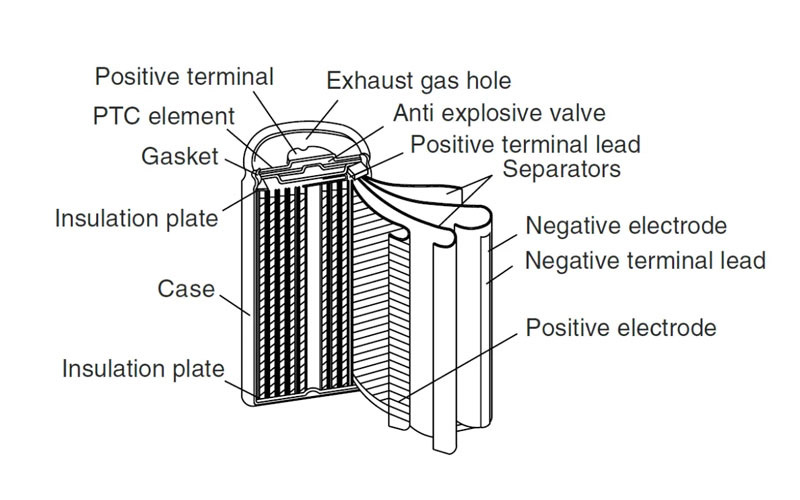The lithium battery are always made of cells, there are two main kinds of cells in the market- Cylindrical cells and Prismatic cells. In this article, we will take you to know what is the difference and Similarity between cylindrical Battery vs prismatic Battery.

What is cylindrical battery cells?
Cylindrical lithium-ion battery is a lithium ion battery with cylindrical shape, so called cylindrical lithium-ion battery. According to the anode materials, cylindrical li-ion battery are divided into lithium cobalt oxides (LiCoO2), lithium manganese (LiMn2O4), lithium nickel manganese cobalt (LiNiMnCoO2 or NMC), lithium aluminum nickel cobalt (LiNiCoAlO2 or NCA), lithium iron phosphate (LiFePO4) and lithium titanate (Li4Ti5O12).

There are many types of cylindrical lithium batteries, including 14500, 14650, 18500, 18650, 21700, 26650, 32650, etc. They are widely used in special equipment, medical equipment, instrumentation, handheld equipment, security and communication.
How are cylindrical cells made?
- Incoming material inspection
- Preparation of positive and negative pole pieces
- Mixing
- Coating
- Pressing
- Baking pole pieces
- Slitting
- Tab forming
- Winding
- Vacuum baking
- Put it in the battery case
- Inject the electrolyte
- Seal
- Formation
- Outer packaging
- Inspection and storage
For details production process, you can check our another article 《What is the production procell of lithium battery cells》
Also there are video to show the production process of cylindrical cells in our fatory.
What is the most commonly cylindrical cells?
The 18650, 21700, and 4680 battery cells used by Tesla batteries are all cylindrical batteries. Driven by mature marketization, cylindrical batteries are the most mature packaging form. Specifically, the 18650 and 21700 cells has a higher yield, and the cost of PACK can be effectively controlled.
What is prismatic battery cells?
Prismatic lithium-ion battery is a lithium ion battery with prismatic shape, so called prismatic lithium-ion battery. The shell of prismatic battery are mostly made of aluminum alloy, stainless steel and other materials, and the internal use of winding or lamination process, the protection of the battery is better than that of aluminum-plastic film battery (ie soft-pack battery), the safety of the battery Relatively cylindrical batteries have also been greatly improved.

The lithium battery aluminum case is developed on the basis of the steel case. Compared with the steel case, the light weight and safety and the performance advantages derived from it make the aluminum case the mainstream of the lithium battery case. The lithium battery aluminum shell is still developing in the direction of high hardness and light weight technology, which will provide the market with more technologically superior lithium battery products. At present, the companies producing square hard-shell batteries include Guoxuan Hi-Tech, Samsung SDI, Lishen, and CATL.
How are prismatic cells made?
Nearly all the production process are same except the Back-end process. The typical difference is that the prismatic battery cells are uses the Lamination process, while the cylindrical battery uses the winding process. For details production process, you can check our another article 《What is the production procell of lithium battery cells》
Also there are video to show the production process of cylindrical cells in our fatory.
What is the most commonly prismatic cells?
50Ah 100Ah, 200Ah is the most commonly prismatic batteries cell in the market, check ELB prismatic cells spec to know more details.
What is the difference between cylindrical cells and prismatic cells?
1. The energy density of prismatic cells is theoretically higher than cylindrical cells. Because the structure of prismatic batteries is relatively simple, the production process is not complicated, also prismatic batteries do not use high strength stainless steel as shell like cylindrical batteries. More and More Electric Vehicle battery apply square battery.
2.With excellent thermal characteristics, the prismatic cell requires less cooling per energy unit when compared to the cylindrical lithium cell format. Additionally, the prismatics offers excellent cycle life expectancies even under high and varied load, which typically has an adverse effect on the life expectancy of other lithium cell formats. With a cycle life of up to four times greater than cylindrical lithium cells, the cost of operation and ownership for prismatics can be significantly lower.
3.Cylindrical battery development is the longest process, the technology is the most mature, its standardization is high as well. And because cylindrical cells have more space between individual cells when they are assembled, they have a big advantage in terms of heat dissipation, and many models with cylindrical cells have adopted lower-cost air cooling technology.
How to choice battery cells for my application? Cylindrical cells or Prismatic cells?
If your lithium application requires high power, long service life and good performance, thinking less about the effective use of space, a cylindrical cell could be your selection. Otherwise, if your application needs to be suitable for a limited space and a higher price is acceptable, a prismatic cell could be better.
When you are not sure what type of lithium cell you should use, try to consider an experienced partner, such as ELB, that is able to provide a power supply solution matching your specific requirement and helps you make a reasonable buying decision.






2 Responses
Do you think our technology is a good fit for use in EV vehicles?
I am Jeff Randazzo, founder and principal owner of Controlled Displacement Technologies LLC. (CDT) and inventor of ChannalBAC™, a non-cellular gap filler. Controlled Displacement™ Technology, is a “disruptive” alternative to cellular foam.
I recently attended the “Battery Show” where I learned of challenges with cellular foam as a gap filler. ChannalBAC’s™ 3-D design provides the critical electrical insulation, thermal management, vibration dampening, and consistent force to maintain the structural integrity of an EV battery’s cell during the expansion and contraction of the battery when charging and discharging.
Cellular foam, open or closed cell, prevents air circulation between battery packs; conversely, ChannalBAC’s channels provide unrestricted air or liquid flow enabling six-sided temperature control for each cell.
Our 3-D design and construction provide infinite and limitless control to dialing the special compression force and dynamic range required for a particular application.
ChannalBAC’s proprietary roll-to-roll manufacturing process requires significantly less energy and reduces CO2 and VOC emissions making it a sustainable alternative to cellular foam.
It should be a good technology, but we only familiar with batteries.